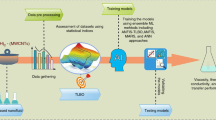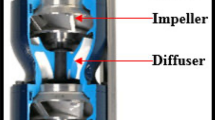Abstract
This study describes the development, modeling, and testing of a hybrid damper for semi-active suspension. The goal of this study is to improve the performance of conventional passive oil dampers using a magneto-rheological (MR) accumulator that consists of a gas accumulator and an MR device. The level of damping is continuously variable by means of control of the applied current in an MR device that is fitted to a floating piston that separates the gas and oil chamber. A small MR device is used to resist the movement of the floating piston. At first, a mathematical model that describes all flows within the damper is formulated and developed in Matlab/Simulink. The MR device is also devised. A mathematical model is adopted to characterize the performance of the device. The formulas derived for the different components of the damper force are combined into a full damper model. Then, the applicability of the MR device to a conventional passive oil damper is tested in a manufactured test environment and evaluated in terms of the damping force vs. the piston velocity. From the results, it is possible to ascertain the MF device’s capability to work as a damper that can supply a variable damping force. Moreover, this research affords a lot of new information about the applicability of MR devices and improvement of the damping force.
Similar content being viewed by others
References
D. Karnopp, M. J. Crosby and R. A. Harwood, Vibration control using semi-active force generators, ASME J. Eng. Ind., 96(2) (1974) 619–626.
K. Yi and B. S. Song, A new adaptive sky-hook control of vehicle semi-active suspensions, Proc. of the I MECH E Part D J. Automob. Eng. 213(3) (1999) 293–303.
C. de Korh, Development of a new continuously variable damper for semi-active suspensions, I. Mech. E. publication, (C389/471) (1992) 141–151.
S. H. Lee, J. H. Park, S. K. Lee, K. J. Youn and K. W. Min, Performance evaluation of passive and semi-active magnetorheological dampers, J. of Mechanical Science and Technology, 21(6) (2007) 913–918.
S. R. Hong, S. B. Choi, Y. T. Choi and N. M. Wereley, A hydro-mechanical model for hysteretic damping force prediction of ER damper: experimental verification, J. of Sound and Vibration, 285 (2005) 1180–1188.
C. T. Lee and B. Y. Moon, Study on the damping performance characteristics analysis of shock absorber of vehicle by considering fluid force, J. of Mechanical Science and Technology, 19(2) (2005) 520–528.
K. Reybrouck, A nonlinear parametric model of an automotive shock absorber, SAE 940869 (1994) 79–86.
A. Sorniotti, N. D’Alfrio and A. Morgando, Shock absorber modeling and experimental testing, SAE 2007-01-0855, 2007.
J. M. Gere and S. Timoshenko, Mechanics of Materials, Third Ed. International Thomson Publishing, pp 488–490.
M. Ahmadian and J. A. Norris, Experimental analysis of magnetorheological dampers when subjected to impact and shock loading, Communication in Nonlinear Science and Numerical Simulation, 13(9) (2008) 1983–1984.
B. F. Spencer Jr, S. J. Dyke, M. K. Sain and J. D. Carlson, Phenomenological model for magnetorheological dampers, J. of Eng. Mech., 123(3) (1997) 230–238.
Author information
Authors and Affiliations
Corresponding author
Additional information
This paper was recommended for publication in revised form by Associate Editor Eung-Soo Shin
Myeong-Kwan Park received the M.S. and Ph.D. degrees from Tokyo Institute of Technology, Tokyo, Japan, in 1988 and 1991, respectively, in mechanical engineering. From 1991 to 1992, he served as a Research Associate in Department Mechanical Engineering, Tokyo Institute of Technology. He is currently a full professor with Department of Mechanical Engineering and a Researcher in the Research Institute of Mechanical Technology at Pusan National University. His research interests are in hydraulic and smart fluid such as magnetic fluid, ER fluid and MR fluid.
Young-Won Yun was born in Busan, Korea, in 1973. He received his B.S. in Mechanical Engineering from Dong-a University, Busan, Korea, in 2000. He also received his M.S. in Mechanical Engineering from Pusan National University, Busan, Korea, in 2003. He is currently working toward his Ph. D at Pusan National University. His current research interests are Electro-hydraulic systems and a robust controller.
Seong-Min Lee received the B.S. degree in Mechanical Engineering from Dong-a University in 2002. He also received his M.S. degree in Interdisciplinary programs in Mechatronics from Pusan National University in 2004, and now is a Ph.D. Candidate in Interdisciplinary in Mechatronics at Pusan National University in Korea. His research field is hydraulic control systems, hydraulic component design and energy saving in hydraulic systems.
Rights and permissions
About this article
Cite this article
Yun, YW., Lee, SM. & Park, MK. A study on the efficiency improvement of a passive oil damper using an MR accumulator. J Mech Sci Technol 24, 2297–2305 (2010). https://doi.org/10.1007/s12206-010-0801-x
Received:
Revised:
Accepted:
Published:
Issue Date:
DOI: https://doi.org/10.1007/s12206-010-0801-x




